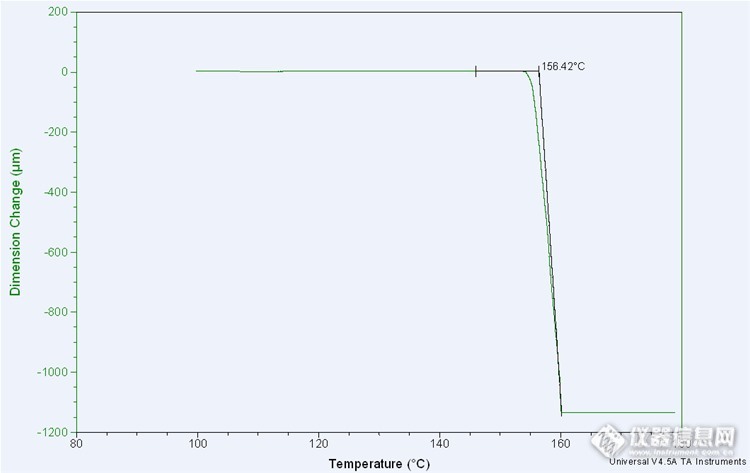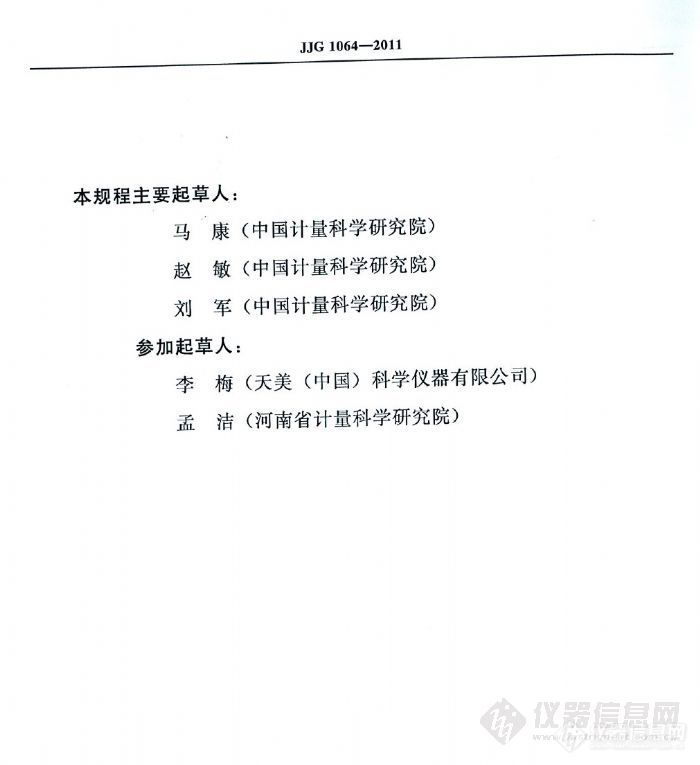又麻烦大家了,这是我在网上找到的标准WJ 2291-1995 热机械分析仪检定规程,但不能下载,不知大家有没有相关的TMA或者热膨胀仪的检定(校准)方法、规程之类的资料啊,万分感谢!!
求助(帮忙找JJG (机械) 4-1990:磁性物分析仪检定规程)
国内目前都有哪些试验机公司生产热机械分析仪器?
热机械分析仪选型方案具体见附件!看了好的在来回!新年也来凑个热闹!附件有两个1.热分析系统评估;2.热机械分析仪选型方案[em09503][img]http://bbs.instrument.com.cn//images/affix.gif[/img][url=http://bbs.instrument.com.cn/download.asp?ID=193126]热机械分析仪选型方案.doc[/url][img]http://bbs.instrument.com.cn//images/affix.gif[/img][url=http://bbs.instrument.com.cn/download.asp?ID=193131]热分析系统评估.rar[/url]
求各分析仪器的检定规程谢谢
有哪位大虾知道氨基酸分析仪的检定规程, 望告知! 急需,谢谢!!
水中油分浓度分析仪检定规程,大家看看有意见吗?(报审稿)
RT,想知道最常见的知名热机械分析仪器进口品牌有哪些?耐驰、TA,别的还有吗?
求助JJG (机械) 94-1992 数字温度测量仪检定规程
各位,请问上海哪所大学、科研所或企业有热机械分析仪(TMA),现在寻找专门的TMA仪器,请各位推荐,谢谢。
【求】JJG 821-2005 总有机碳分析仪检定规程谢谢。yephon@163.com
我们实验室主要做橡胶鞋底材料、EVA材料的研究,现在准备采购动态热机械分析仪 DMA 大家有什么推荐性的配置和品牌,有用过的老师请指导一下;另外我公司准备采购一台GPC,有经验的朋友可以加我QQ交流交流,有意向是买高温的,不知大家是否有更好的建议。商家可将报价发到站内信箱,或者跟帖讨论。 在这里先谢谢各位前辈啦!

参加采购版块的活动来啦一、先来个仪器整体的照片http://ng1.17img.cn/bbsfiles/images/2014/10/201410171507_518801_2552812_3.png图1 仪器整体图仪器介绍:购入公司时间:2008年,使用至今快7年了。还未出现任何大的状况,中间唯一一次大的情况是我们的检测人员在给炉体做清洁时,将玻璃炉体打破,购买这个炉体花了将近2万人民币。其它问题还未发现。仪器厂家:TA公司。仪器名称及型号:热机械分析仪(Q400)。一、仪器测试原理1.热机械分析(thermomechanical analyzer,TMA):是在程序控温非振动负载下(形变模式有膨胀、压缩、针入、拉伸或弯曲等不同形式),测量试样形变与温度关系的技术。我们实验室主要检测样品的膨胀系数,膨胀测量模式所用负载很小,一般是0.05N。2.如果为振动负载,即负载呈现周期性变化,则称为动态负载热机械分析仪(DLTMA)。该模式是TMA仪器功能的扩展,可测量试样的杨氏模量。3.热机械分析仪的内部结构:http://ng1.17img.cn/bbsfiles/images/2014/10/201410171508_518802_2552812_3.png图2 仪器内部结构图(1)主要部分说明:1-气体出口旋塞,2-螺纹夹,3-炉体加热快,4-炉体夹套,5-试样支架,6-炉温传感器,7-试样温度传感器,9-测量探头,10-垫圈,12-力发生器,13-位移传感器(LVDT),14-弯曲轴承,15-校正砝码,16-保护气进口,18-真空连接与吹扫气入口,20-试样。(2)最常用的TMA测量模式示意图(箭头表示探头作用力方向),如图3所示:http://ng1.17img.cn/bbsfiles/images/2014/10/201410171510_518803_2552812_3.png图3 测量探头示意图我们实验室使用的是第一种压缩或膨胀的测量模式。(1)测试过程:试样探头上下垂直移动,探头上的负载力发生器产生,位移传感器测量探头的位置。探头直接放置于试样上,或者置于试样上的石英片上。测量试样温度的热电偶置于试样上。(2)TMA试样支架和探头由石英玻璃制造,石英在温度高于1100℃范围内线膨胀系数极小。不可将石英玻璃加热至1100℃以上,因为高于该温度会结晶。(3)位移传感器(LVDT),线圈系统内的铁磁芯与测量探头连接,产生与位移成正比的电信号。电磁线性马达可消除部件的重力,保证探头传输至希望的力至试样。使
动态热机械分析仪DMA+300 产品描述法国Metravib公司的DMA+300 基于研究和工业测试的广泛需求,应运而生,能对材料的复合模量和损耗因子等进行高精密度测量。DMA+300具有非常坚固的机架,这种高刚度决定了可以测量的材料的刚度和频率的范围很宽。DMA+300配置了空气轴承,使其能达到更低的力值,模量跨度更大。同时该设备针对具体测试需求,可配备多种多样的样品夹具,拉、压、弯、剪、膏状材料测试等。结合特有DMA suite分析软件,使得它成为一种崭新的动态热机械测试仪器,其性能和应用范围远远超过了传统的低力值DMA产品。主要特点1. 高刚度机架(高于液压伺服机器)2. 力值范围更宽,最大力值150N,峰峰值为300N,能测试更多种类的材料3. 独一无二的刚度测量范围:单次实验中刚度变化壳跨越7个数量级4. 独一无二的频率测试范围:10-5~1000Hz5. 配置了空气轴承,使其能达到更低的力值,模量跨度更大6. 高测量精度,包括力值传感器精度、温度控制精度和位移精度等7. 可进行不同尺寸材料的样品分析[img]https://ng1.17img.cn/bbsfiles/images/2023/04/202304302145395359_4034_1602049_3.png[/img][img]https://ng1.17img.cn/bbsfiles/images/2023/04/202304302145395808_9723_1602049_3.png[/img]

刚才浏览网页,发现有关氨基酸分析仪的一项大事,《氨基酸分析仪检定规程》已经宣贯实施了。http://www.instrument.com.cn/show/news/20110809/066199.shtml这个的颁布说明了氨基酸分析仪越来越受重视,但是目前还不知道是推荐还是强检的,有幸拿到了扫描件,因为涉及版权,只发第前3页扫描件啊,了解下。http://ng1.17img.cn/bbsfiles/images/2011/08/201108101046_309482_2098687_3.jpghttp://ng1.17img.cn/bbsfiles/images/2011/08/201108101046_309483_2098687_3.jpghttp://ng1.17img.cn/bbsfiles/images/2011/08/201108101047_309484_2098687_3.jpg有氨基酸分析仪的赶紧了解了解!
求助,求推荐懂得梅特勒热机械分析仪设备维修的大佬,梅特勒1600那一款,问题是加热丝断裂
资料有点老,不知有没更新的,但愿与各位版友有参考价值[img]http://www.instrument.com.cn/bbs/images/affix.gif[/img][url=http://www.instrument.com.cn/bbs/download.asp?ID=152100]JJG 014-1996 热分析仪检定规程[/url]
我对热膨胀仪DIL、热机械分析仪TMA、动态力学分析仪DMA 之间界定不是很清楚,如果只用来测热膨胀系数的话好像三者都可以,但具体的测量原理有什么不同呢? 尤其是DIL和TMA总感觉两个仪器的功能差不多,DMA还可以加上力的作用那个可以测阻尼运动等等,那DIL和TMA有什么区别啊? 希望清楚的坛友帮我解答下?谢谢。
【网络讲座】:动态热机械分析仪(DMA)技术及应用 【讲座时间】:2016-09-22 14:00【主讲人】:寇云峰,梅特勒-托利多技术应用顾问,材料工程专业,从事热分析行业工作多年,具有丰富的热分析仪器使用及应用的经验。【会议简介】本次讲座将主要介绍动态热机械分析(DMA)的原理和一些应用,包括仪器的测试原理,测试方式以及DMA不同夹具各自的特点和应用。-------------------------------------------------------------------------------1、报名条件:只要您是仪器网注册用户均可报名参加。2、报名参会:http://www.instrument.com.cn/webinar/meeting/meetingInsidePage/18673、报名及参会咨询:QQ群—290101720,扫码入群“大讲堂”http://ng1.17img.cn/bbsfiles/images/2017/01/201701191701_672390_2507958_3.gif
请问哪位大侠有JJG945-2010微量氧分析仪检定规程。谢谢。。。。。。。。
JJG 205-2005 机械式温湿度计检定规程谁有此规程,能否传一份?
哪位大侠能告诉在下,在网上哪里能下载《水中油份浓度分析仪检定规程JJG950-2000》

热机械分析仪选型调研,参与一下,申明绝非广告,实例已采购的了设备热机械分析仪选型方案成型仿真过程中最主要也是最困难的问题是建立玻璃在成型过程中所表现出的粘弹性本构关系,在研究粘弹性本构关系过程中,必须通过试验测定材料基本粘弹特性,考虑本构关系测量以及成型过程的限制,测量设备应满足以下基本要求:1、测量温度范围:常温~650℃2、测量基本应力应变关系3、恒温下测量松弛函数与蠕变函数4、变温下测量松弛函数与蠕变函数5、测量玻璃化转变、软化点等6、具有一定的DMA测试能力经过调研,共筛选出五种热分析仪器(附件一),综合考虑测试能力与价格因素,美国TA公司的TMAQ400EM在各方面均满足研究需求,TMA系列用户多为高级研究机构,TMAQ400EM是该系列的第五代产品,TA公司提供了良好的技术支持与售后服务,因此,最终选定TMAQ400EM作为玻璃成型过程粘弹性本构关系的研究设备。http://ng1.17img.cn/bbsfiles/images/2011/12/201112281014_341888_2961690_3.jpghttp://ng1.17img.cn/bbsfiles/images/2011/12/201112281014_341889_2961690_3.jpghttp://ng1.17img.cn/bbsfiles/images/2011/12/201112281014_341890_2961690_3.jpghttp://ng1.17img.cn/bbsfiles/images/2011/12/201112281014_341891_2961690_3.jpghttp://ng1.17img.cn/bbsfiles/images/2011/12/201112281017_341895_2961690_3.jpghttp://ng1.17img.cn/bbsfiles/images/2011/12/201112281017_341897_2961690_3.jpghttp://ng1.17img.cn/bbsfiles/images/2011/12/201112281017_341900_2961690_3.jpg
JJG (机械) 100-1992 磁粉探伤机检定规程[img]http://www.instrument.com.cn/bbs/images/affix.gif[/img][url=http://www.instrument.com.cn/bbs/download.asp?ID=50940]JJG (机械) 100-1992 磁粉探伤机检定规程[/url]
JJG (石油) 07-1999 机械式井下压力计检定规程[img]http://www.instrument.com.cn/bbs/images/affix.gif[/img][url=http://www.instrument.com.cn/bbs/download.asp?ID=50854]JJG (石油) 07-1999 机械式井下压力计检定规程[/url]
我公司一台 TMA 热机械分析仪 ,拉伸样品台坏了,哪家国内厂商可以制作??玻璃样品台的材质应该是熔融石英~~~ 拜托,急用~~
实验室认证认可热重 差示扫描量热仪(tg-dsc)、热机械分析仪(TMA)不确定度评定,大家有模板吗?谢谢分享啊~~
新手求助 JJG694-1990[url=https://insevent.instrument.com.cn/t/Wp][color=#3333ff]原子吸收[/color][/url]检定规程 JJG861-1994酶标分析仪检定方法谢谢各位大侠
[align=center][font='times new roman'][size=24px]动态热机械分析仪[/size][/font][font='times new roman'][size=24px]自[/size][/font][font='times new roman'][size=24px]检规程[/size][/font][/align][font='times new roman'][size=18px]1 [/size][/font][font='times new roman'][size=18px]前言[/size][/font][font='times new roman'][size=16px]本规程参考[/size][/font][font='times new roman'][size=16px]玻璃化转变温度[/size][/font][font='times new roman'][size=16px]测试国际标准[/size][/font][font='times new roman'][size=16px]ASTM E1640-18[/size][/font][font='times new roman'][size=16px]、温度校准国际标准[/size][/font][font='times new roman'][size=16px]ASTM E1867-2018[/size][/font][font='times new roman'][size=16px]、储能模量校准国际标准[/size][/font][font='times new roman'][size=16px]ASTM E2254-2018[/size][/font][font='times new roman'][size=16px]和损耗模量校准国际标准[/size][/font][font='times new roman'][size=16px]ASTM E2425-16[/size][/font][font='times new roman'][size=16px]与美国沃特世[/size][/font][font='times new roman'][size=16px]公司[/size][/font][font='times new roman'][size=16px]DMA Q800[/size][/font][font='times new roman'][size=16px]仪器操作说明书编写。[/size][/font][font='times new roman'][size=18px]2 [/size][/font][font='times new roman'][size=18px]范围[/size][/font][font='times new roman'][size=16px]动态热机械分析仪[/size][/font][font='times new roman'][size=16px]([/size][/font][font='times new roman'][size=16px]以下简称[/size][/font][font='times new roman'][size=16px]D[/size][/font][font='times new roman'][size=16px]MA)[/size][/font][font='times new roman'][size=16px]是研究材料在周期振动应力下,随温度或频率变化的力学性能和粘弹性能的仪器。适用于热塑性聚合物、热固性聚合物和在玻璃化转变区间热稳定的部分结晶材料。适用于温度范围为[/size][/font][font='times new roman'][size=16px]R[/size][/font][font='times new roman'][size=16px]T~300 [/size][/font][font='times new roman'][size=16px]o[/size][/font][font='times new roman'][size=16px]C[/size][/font][font='times new roman'][size=16px],材料的弹性模量[/size][/font][font='times new roman'][size=16px]范围[/size][/font][font='times new roman'][size=16px]为[/size][/font][font='times new roman'][size=16px]1 MP[/size][/font][font='times new roman'][size=16px]a[/size][/font][font='times new roman'][size=16px]~1000 [/size][/font][font='times new roman'][size=16px]GPa[/size][/font][font='times new roman'][size=16px],单悬臂夹具测试。[/size][/font][font='times new roman'][size=16px]本规程适用于新安装、使用中和维修后的[/size][/font][font='times new roman'][size=16px]动态热机械分析仪[/size][/font][font='times new roman'][size=16px]的检定。[/size][/font][font='times new roman'][size=16px]2.1 [/size][/font][font='times new roman'][size=16px]原理[/size][/font][align=left][font='times new roman'][size=16px]DMA[/size][/font][font='times new roman'][size=16px]是用来测量各种材料[/size][/font][font='times new roman'][size=16px]宽范围[/size][/font][font='times new roman'][size=16px]内的力学性质。包括聚合物,其行为特征既像弹性固体又像粘性液体,因此具有粘弹性。[/size][/font][font='times new roman'][size=16px]DMA[/size][/font][font='times new roman'][size=16px]在两个重要方面不同于其它的力学测试方法:第一,传统的拉伸测试设备[/size][/font][font='times new roman'][size=16px]仅关注[/size][/font][font='times new roman'][size=16px]弹性组[/size][/font][font='times new roman'][size=16px]份[/size][/font][font='times new roman'][size=16px]。而在许多应用中,非弹性或粘性的组[/size][/font][font='times new roman'][size=16px]份[/size][/font][font='times new roman'][size=16px]是十分关键的。第二,拉伸测试设备主要在材料的线性[/size][/font][font='times new roman'][size=16px]粘弹范围[/size][/font][font='times new roman'][size=16px]外进行测试。而[/size][/font][font='times new roman'][size=16px]DMA[/size][/font][font='times new roman'][size=16px]主要在材料的线性[/size][/font][font='times new roman'][size=16px]粘弹区[/size][/font][font='times new roman'][size=16px]进行测试,因此[/size][/font][font='times new roman'][size=16px]DMA[/size][/font][font='times new roman'][size=16px]对材料的结构更加敏感。[/size][/font][/align][font='times new roman'][size=16px]DMA[/size][/font][font='times new roman'][size=16px]可通过瞬态实验或动态实验测定材料的粘弹性。最常用的测试是动态振荡测试,[/size][/font][font='times new roman'][size=16px]在程序控温和频率等控制下,对[/size][/font][font='times new roman'][size=16px]材料施加正弦变化的应力[/size][/font][font='times new roman'][size=16px]([/size][/font][font='times new roman'][size=16px]或应变[/size][/font][font='times new roman'][size=16px])[/size][/font][font='times new roman'][size=16px],测量产生的正弦应变[/size][/font][font='times new roman'][size=16px]([/size][/font][font='times new roman'][size=16px]或应力[/size][/font][font='times new roman'][size=16px])[/size][/font][font='times new roman'][size=16px]响应[/size][/font][font='times new roman'][size=16px]。同时也测量两个正弦波相位的偏移。对于完全弹性的材料,相位角为[/size][/font][font='times new roman'][size=16px]0 [/size][/font][font='times new roman'][size=16px]o[/size][/font][font='times new roman'][size=16px]([/size][/font][font='times new roman'][size=16px]图[/size][/font][font='times new roman'][size=16px]1a[/size][/font][font='times new roman'][size=16px])[/size][/font][font='times new roman'][size=16px];而对于完全粘性的材料,相位角的偏移为[/size][/font][font='times new roman'][size=16px]90[/size][/font][font='times new roman'][size=16px] o[/size][/font][font='times new roman'][size=16px]([/size][/font][font='times new roman'][size=16px]图[/size][/font][font='times new roman'][size=16px]1b[/size][/font][font='times new roman'][size=16px])[/size][/font][font='times new roman'][size=16px]。[/size][/font][font='times new roman'][size=16px]粘弹性材料的相位角则居于二者之间[/size][/font][font='times new roman'][size=16px],如图[/size][/font][font='times new roman'][size=16px]1[/size][/font][font='times new roman'][size=16px]c[/size][/font][font='times new roman'][size=16px]所示[/size][/font][font='times new roman'][size=16px]。[/size][/font][font='times new roman'][size=16px]如图[/size][/font][font='times new roman'][size=16px]1d[/size][/font][font='times new roman'][size=16px]所示,模量的定义为应力[/size][/font][font='times new roman'][size=16px]/[/size][/font][font='times new roman'][size=16px]应变,由此计算复合模量[/size][/font][font='times new roman'][size=16px]E*[/size][/font][font='times new roman'][size=16px],根据[/size][/font][font='times new roman'][size=16px]E*[/size][/font][font='times new roman'][size=16px]和测得的[/size][/font][font='times new roman'][size=16px]δ[/size][/font][font='times new roman'][size=16px],可计算储能模量和损耗模量,如式[/size][/font][font='times new roman'][size=16px](1)[/size][/font][font='times new roman'][size=16px]所示。[/size][/font][font='times new roman'][size=16px]E′[/size][/font][font='times new roman'][size=16px]为储能模量是材料的弹性组份,与样品的刚度有关;[/size][/font][font='times new roman'][size=16px]E′′[/size][/font][font='times new roman'][size=16px]为损耗模量是材料的粘性组份,与样品分子运动中机械性能的弥散程度有关;[/size][/font][font='times new roman'][size=16px]Tan δ[/size][/font][font='times new roman'][size=16px]是储能模量与损耗模量的比值,它提供了弹性组份与粘性组份之间关系的信息。[/size][/font][align=right][font='times new roman'][size=16px] [/size][/font][font='times new roman'][size=16px](1)[/size][/font][/align][font='times new roman'][size=16px]式中:[/size][/font][font='times new roman'][size=16px]E[/size][/font][font='times new roman'][size=16px]* ——[/size][/font][font='times new roman'][size=16px]复合模量;[/size][/font][font='times new roman'][size=16px]E[/size][/font][font='times new roman'][size=16px]′ ——[/size][/font][font='times new roman'][size=16px]储能模量;[/size][/font][font='times new roman'][size=16px]E[/size][/font][font='times new roman'][size=16px]′′——[/size][/font][font='times new roman'][size=16px]损耗模量。[/size][/font][align=center][img]" style="max-width: 100% max-height: 100% [/img][/align][align=center][img]" style="max-width: 100% max-height: 100% [/img][/align][align=center][font='times new roman']图[/font][font='times new roman']1 [/font][font='times new roman']材料的粘弹性[/font][/align][font='times new roman'][size=16px]瞬态测试包括蠕变或应力松弛。在蠕变中,一定的应力施加在样品上并保持恒定,同时测量形变与时间的关系。一段时间后去除应力,测量回复过程。在应力松弛中,一定的形变施加在样品上并保持恒定,测量应力的衰减与时间的关系。[/size][/font][font='times new roman'][size=16px] [/size][/font][font='times new roman'][size=16px]材料被施加正弦应力[/size][/font][font='times new roman'][size=16px]([/size][/font][font='times new roman'][size=16px]或应变[/size][/font][font='times new roman'][size=16px])[/size][/font][font='times new roman'][size=16px]后,由于粘弹性,材料的应力[/size][/font][font='times new roman'][size=16px]([/size][/font][font='times new roman'][size=16px]或应变[/size][/font][font='times new roman'][size=16px])[/size][/font][font='times new roman'][size=16px]滞后于施加的应力[/size][/font][font='times new roman'][size=16px]([/size][/font][font='times new roman'][size=16px]或应变[/size][/font][font='times new roman'][size=16px])[/size][/font][font='times new roman'][size=16px],出现相位差。当温度升高达到玻璃化转变温度时,材料内部高分子的结构形态发生变化,链段开始运动,材料的刚度大幅度变化,这一变化会同时反映在储能模量、损耗模量和损耗因子等多个参数上。[/size][/font][font='times new roman'][size=16px]DMA[/size][/font][font='times new roman'][size=16px]是通过上述多个参数随温度的变化来探测材料的玻璃化转变温度。通常将储能模量急剧下降的起始点对应的温度[/size][/font][font='times new roman'][size=16px]T[/size][/font][font='times new roman'][size=16px]g[/size][/font][font='times new roman'][size=16px]、损耗模量峰值温度[/size][/font][font='times new roman'][size=16px]T[/size][/font][font='times new roman'][size=16px]l[/size][/font][font='times new roman'][size=16px]和损耗因子峰值温度[/size][/font][font='times new roman'][size=16px]T[/size][/font][font='times new roman'][size=16px]t[/size][/font][font='times new roman'][size=16px]作为玻璃化转变温度,如图[/size][/font][font='times new roman'][size=16px]2[/size][/font][font='times new roman'][size=16px]所示。[/size][/font][font='times new roman'][size=16px] [/size][/font][align=center][font='times new roman'][size=16px] [/size][/font][img]" style="max-width: 100% max-height: 100% [/img][/align][align=center][img]" style="max-width: 100% max-height: 100% [/img][font='times new roman'][size=16px] [/size][/font][img]" style="max-width: 100% max-height: 100% [/img][/align][align=center][font='times new roman']图[/font][font='times new roman'] [/font][font='times new roman']2 [/font][font='times new roman']材料储能模量、损耗模量和损耗因子与温度的关系曲线[/font][/align][font='times new roman'][size=16px]2.2 [/size][/font][font='times new roman'][size=16px]构成[/size][/font][font='times new roman'][size=16px]仪器由加热炉体、空气过滤器、空气压缩机、夹具和计算机等部分组成。[/size][/font][font='times new roman'][size=18px]3 [/size][/font][font='times new roman'][size=18px]计量单位[/size][/font][font='times new roman'][size=16px]本规程中的计量单位一律采用国家颁布的法定计量单位及其符号。[/size][/font][font='times new roman'][size=16px] [/size][/font][font='times new roman'][size=16px]测量中选取的温度采用[/size][/font][font='times new roman'][size=16px]T[/size][/font][font='times new roman'][size=16px]i[/size][/font][font='times new roman'][size=16px]表达,单位为[/size][/font][font='times new roman'][size=16px] [/size][/font][font='times new roman'][size=16px]o[/size][/font][font='times new roman'][size=16px]C[/size][/font][font='times new roman'][size=16px]。[/size][/font][font='times new roman'][size=16px]试样的模量采用[/size][/font][font='times new roman'][size=16px]E[/size][/font][font='times new roman'][size=16px]i[/size][/font][font='times new roman'][size=16px]表达,单位为[/size][/font][font='times new roman'][size=16px]MPa[/size][/font][font='times new roman'][size=16px]。[/size][/font][font='times new roman'][size=18px]4 [/size][/font][font='times new roman'][size=18px]计量性能要求[/size][/font][font='times new roman'][size=16px]4.1 [/size][/font][font='times new roman'][size=16px]量具[/size][/font][font='times new roman'][size=16px]应符合[/size][/font][font='times new roman'][size=16px]GB/T 1216[/size][/font][font='times new roman'][size=16px]要求的千分尺或符合[/size][/font][font='times new roman'][size=16px]GB/T 21389[/size][/font][font='times new roman'][size=16px]要求的游标类卡尺。测量不确定度[/size][/font][font='times new roman'][size=16px]±0.01 mm[/size][/font][font='times new roman'][size=16px]。[/size][/font][font='times new roman'][size=16px]4.2 [/size][/font][font='times new roman'][size=16px]夹具[/size][/font][font='times new roman'][size=16px] [/size][/font][font='times new roman'][size=16px]要求夹具能够夹紧试样。试样被固定在夹具的一端或者两端。[/size][/font][font='times new roman'][size=16px]4.3 [/size][/font][font='times new roman'][size=16px]周期性应力[/size][/font][font='times new roman'][size=16px]([/size][/font][font='times new roman'][size=16px]应变[/size][/font][font='times new roman'][size=16px])[/size][/font][font='times new roman'][size=16px] [/size][/font][font='times new roman'][size=16px]能够给试样施加周期性变形[/size][/font][font='times new roman'][size=16px]([/size][/font][font='times new roman'][size=16px]应变[/size][/font][font='times new roman'][size=16px])[/size][/font][font='times new roman'][size=16px]或者周期性应力。可施加后卸载变形,或[/size][/font][font='times new roman'][size=16px]者持续性施加变形。[/size][/font][font='times new roman'][size=16px]4.4 [/size][/font][font='times new roman'][size=16px]探测器[/size][/font][font='times new roman'][size=16px]温度可读数±[/size][/font][font='times new roman'][size=16px]0.1 °C[/size][/font][font='times new roman'][size=16px],[/size][/font][font='times new roman'][size=16px]力值可[/size][/font][font='times new roman'][size=16px]读数[/size][/font][font='times new roman'][size=16px]1 %[/size][/font][font='times new roman'][size=16px],频率可读数[/size][/font][font='times new roman'][size=16px]±0.1 Hz[/size][/font][font='times new roman'][size=16px]。[/size][/font][font='times new roman'][size=16px]4.5 [/size][/font][font='times new roman'][size=16px]温度控制和炉体[/size][/font][font='times new roman'][size=16px]可步阶或斜坡加热或冷却试样。温度控制器足够稳定允许测试试样温度±[/size][/font][font='times new roman'][size=16px]0.5 °C[/size][/font][font='times new roman'][size=16px]。温度测试精度为[/size][/font][font='times new roman'][size=16px]±1 °C[/size][/font][font='times new roman'][size=16px]。[/size][/font][font='times new roman'][size=18px]5[/size][/font][font='times new roman'][size=18px]技术要求[/size][/font][font='times new roman'][size=16px]5.1[/size][/font][font='times new roman'][size=16px]外观要求[/size][/font][font='times new roman'][size=16px]5.1.1[/size][/font][font='times new roman'][size=16px]仪器无影响计量性能的损伤。面板上标志清晰,标明仪器名称、型号、生产厂名、安装日期和出厂编号。[/size][/font][font='times new roman'][size=16px]5.1.2 [/size][/font][font='times new roman'][size=16px]仪器要完整,附件齐全[/size][/font][font='times new roman'][size=16px]([/size][/font][font='times new roman'][size=16px]包含说明书[/size][/font][font='times new roman'][size=16px])[/size][/font][font='times new roman'][size=16px]。[/size][/font][font='times new roman'][size=16px]5.1.3[/size][/font][font='times new roman'][size=16px]仪器平稳地置于台面上,装配牢固,各个调节旋钮、按钮和开关均能正常工作,无松动现象。[/size][/font][font='times new roman'][size=16px]5.2 [/size][/font][font='times new roman'][size=16px]计量器具控制[/size][/font][font='times new roman'][size=16px]计量器具的控制包括首次检定、后续检定以及使用中检查。[/size][/font][font='times new roman'][size=16px] [/size][/font][font='times new roman'][size=18px]6 [/size][/font][font='times new roman'][size=18px]检定条件[/size][/font][font='times new roman'][size=16px]6.1 [/size][/font][font='times new roman'][size=16px]检定设备和检定用的标准物质[/size][/font][font='times new roman'][size=16px]6.1.1 [/size][/font][font='times new roman'][size=16px]标准配置的钢片,聚碳酸酯[/size][/font][font='times new roman'][size=16px](PC)[/size][/font][font='times new roman'][size=16px]片,金属[/size][/font][font='times new roman'][size=16px]In[/size][/font][font='times new roman'][size=16px]和[/size][/font][font='times new roman'][size=16px]Sn[/size][/font][font='times new roman'][size=16px]标样。[/size][/font][font='times new roman'][size=16px]6.1.2 [/size][/font][font='times new roman'][size=16px]检定环境[/size][/font][font='times new roman'][size=16px](1) [/size][/font][font='times new roman'][size=16px]环境温度:[/size][/font][font='times new roman'][size=16px](20-40) [/size][/font][font='times new roman'][size=16px]o[/size][/font][font='times new roman'][size=16px]C[/size][/font][font='times new roman'][size=16px];[/size][/font][font='times new roman'][size=16px](2) [/size][/font][font='times new roman'][size=16px]相对湿度:[/size][/font][font='times new roman'][size=16px]≤75%[/size][/font][font='times new roman'][size=16px];[/size][/font][font='times new roman'][size=16px](3) [/size][/font][font='times new roman'][size=16px]仪器工作的电压稳定且接地良好;[/size][/font][font='times new roman'][size=16px](4) [/size][/font][font='times new roman'][size=16px]无灰尘、腐蚀性气体、振动、异常气流波动等影响;[/size][/font][font='times new roman'][size=16px](5) [/size][/font][font='times new roman'][size=16px]避免阳光直射,远离强磁场、电场以及其它辐射。[/size][/font][font='times new roman'][size=16px]6.2 [/size][/font][font='times new roman'][size=16px]检定项目和检定方法[/size][/font][font='times new roman'][size=16px]6.2.1 [/size][/font][font='times new roman'][size=16px]外观及正常工作性检查[/size][/font][font='times new roman'][size=16px]该项目检定结果应符合本规程第[/size][/font][font='times new roman'][size=16px]5.1[/size][/font][font='times new roman'][size=16px]条外观要求。仪器各部件完好,开机后能正常运行。[/size][/font][font='times new roman'][size=16px]6.2.2 [/size][/font][font='times new roman'][size=16px]仪器校正[/size][/font][font='times new roman'][size=16px]6.2.2.1 [/size][/font][font='times new roman'][size=16px]位置校正[/size][/font][font='times new roman'][size=16px]仪器初始安装、关机重启后需要执行此项校正。移除所有固定及活动部分夹具,进行位置校正。[/size][/font][font='times new roman'][size=16px]6.2.2.2 [/size][/font][font='times new roman'][size=16px]电子校正[/size][/font][font='times new roman'][size=16px]对仪器主机内模拟电路版上的电子组件进行校正。拆掉仪器上安装的夹具,使空气轴承处于浮动状态,安装装运固定架,进行电子校正。[/size][/font][font='times new roman'][size=16px]6.2.2.3 [/size][/font][font='times new roman'][size=16px]力学校正[/size][/font][font='times new roman'][size=16px]包含平衡与重量校正两部分。平衡校正是测量需要多少力才能将空的驱动轴浮动;重量校正测量需要多少力量才能将有放砝码的驱动轴浮动。拆除仪器上所安装的固定和活动部分夹具,关闭炉子,进行平衡校正部分。完成后,开始进行重量校正部分。将仪器配备的[/size][/font][font='times new roman'][size=16px]100 g[/size][/font][font='times new roman'][size=16px]重砝码放在驱动轴顶端的燕尾槽上,确认砝码置中,不会碰到热电偶,关闭炉子进行重量校正。[/size][/font][font='times new roman'][size=16px] [/size][/font][font='times new roman'][size=16px]6.2.2.4 [/size][/font][font='times new roman'][size=16px]动态校正[/size][/font][font='times new roman'][size=16px] [/size][/font][font='times new roman'][size=16px]采用已知刚性和阻尼的钢片为参考物校正仪器动态性能。安装[/size][/font][font='times new roman'][size=16px]35 mm[/size][/font][font='times new roman'][size=16px]双悬臂夹具,关闭炉子开始进行夹具质量校正部分,完成后[/size][/font][font='times new roman'][size=16px]进行柔量校正[/size][/font][font='times new roman'][size=16px]。测定厚钢片的宽度与厚度,输入尺寸后用[/size][/font][font='times new roman'][size=16px]12[/size][/font][font='times new roman'][size=16px]磅扭矩的扭力扳手固定钢片。关闭炉子后,开始进行[/size][/font][font='times new roman'][size=16px]夹具柔量校正[/size][/font][font='times new roman'][size=16px]。完成后拆下厚钢片,继续下一步[/size][/font][font='times new roman'][size=16px]0.12 mm[/size][/font][font='times new roman'][size=16px]钢片校正,装上[/size][/font][font='times new roman'][size=16px]0.12 mm[/size][/font][font='times new roman'][size=16px]钢片[/size][/font][font='times new roman'][size=16px]([/size][/font][font='times new roman'][size=16px]使用约[/size][/font][font='times new roman'][size=16px]8-10[/size][/font][font='times new roman'][size=16px]磅的扭矩[/size][/font][font='times new roman'][size=16px])[/size][/font][font='times new roman'][size=16px],确保钢片位置[/size][/font][font='times new roman'][size=16px]不[/size][/font][font='times new roman'][size=16px]偏斜,开始进行[/size][/font][font='times new roman'][size=16px]0.12 mm[/size][/font][font='times new roman'][size=16px]钢片校正。此后依序装上厚度[/size][/font][font='times new roman'][size=16px]0.25[/size][/font][font='times new roman'][size=16px]、[/size][/font][font='times new roman'][size=16px]0.50[/size][/font][font='times new roman'][size=16px]和[/size][/font][font='times new roman'][size=16px]0.7 6mm[/size][/font][font='times new roman'][size=16px]薄钢片[/size][/font][font='times new roman'][size=16px]进行柔量校正[/size][/font][font='times new roman'][size=16px]。[/size][/font][font='times new roman'][size=16px]6.2.3[/size][/font][font='times new roman'][size=16px]夹具校正[/size][/font][font='times new roman'][size=16px]选择“[/size][/font][font='times new roman'][size=16px]Single/Dual Cantilever”[/size][/font][font='times new roman'][size=16px]校正,安装下夹具,注意与驱动杆同轴,关闭炉门,点击[/size][/font][font='times new roman'][size=16px]Calibrate[/size][/font][font='times new roman'][size=16px]进行校准,等待出现[/size][/font][font='times new roman'][size=16px]“successful”[/size][/font][font='times new roman'][size=16px]字样,表明校准通过,点击[/size][/font][font='times new roman'][size=16px]Next[/size][/font][font='times new roman'][size=16px]进入柔量校准[/size][/font][font='times new roman'][size=16px]。安装上夹具,标准样品[/size][/font][font='times new roman'][size=16px]([/size][/font][font='times new roman'][size=16px]短厚钢片[/size][/font][font='times new roman'][size=16px])[/size][/font][font='times new roman'][size=16px]。注意安装时先将驱动杆切换至浮动状态,将样品放好后,用扭力螺丝刀[/size][/font][font='times new roman'][size=16px](8~10 Nm)[/size][/font][font='times new roman'][size=16px]先紧固上夹具上的螺钉,之后紧固中间小夹具上的螺钉,紧固过程注意不要下压夹具。输入样品尺寸,点击[/size][/font][font='times new roman'][size=16px]Calibrate[/size][/font][font='times new roman'][size=16px]进行校准,待出现[/size][/font][font='times new roman'][size=16px]“successful”[/size][/font][font='times new roman'][size=16px]字样,表明校准通过,点击[/size][/font][font='times new roman'][size=16px]Next[/size][/font][font='times new roman'][size=16px]查看报[/size][/font][font='times new roman'][size=16px]告,报告中出现的校准结果应为:[/size][/font][font='times new roman'][size=16px]Compliance[/size][/font][font='times new roman'][size=16px]:[/size][/font][font='times new roman'][size=16px]≤0.8 [/size][/font][font='times new roman'][size=16px]μm[/size][/font][font='times new roman'][size=16px]/N[/size][/font][font='times new roman'][size=16px]。至此,夹具校正结束[/size][/font][font='times new roman'][size=16px]。[/size][/font][font='times new roman'][size=16px]6.2.[/size][/font][font='times new roman'][size=16px]4[/size][/font][font='times new roman'][size=16px] [/size][/font][font='times new roman'][size=16px]温度校正[/size][/font][font='times new roman'][size=16px]更换夹具、加热速率、吹扫气氛都会影响温度的准确性。一旦开始执行温度校正,热电偶位置不可移动,夹具类型不可更换。[/size][/font][font='times new roman'][size=16px]调整热电偶位置。旋松热电偶夹上的螺丝,移动热电偶至靠近试样但不接触试样,将其固定在试样侧面约[/size][/font][font='times new roman'][size=16px]2~3 mm[/size][/font][font='times new roman'][size=16px]处。如有必要,可弯曲热电偶套管至所要的角度。注意,弯曲角度不得过大,否则会损坏热电偶。重新旋紧热电偶夹的螺丝。[/size][/font][font='times new roman'][size=16px]使用两片钢片夹[/size][/font][font='times new roman'][size=16px]持标准[/size][/font][font='times new roman'][size=16px]金属物质[/size][/font][font='times new roman'][size=16px]In[/size][/font][font='times new roman'][size=16px]和[/size][/font][font='times new roman'][size=16px]Sn[/size][/font][font='times new roman'][size=16px],金属的长度需[/size][/font][font='times new roman'][size=16px]延展至单悬臂[/size][/font][font='times new roman'][size=16px]夹具边缘,测量其熔点,对温度进行校准。[/size][/font][font='times new roman'][size=16px]采用控制力模式,预[/size][/font][font='times new roman'][size=16px]加载力[/size][/font][font='times new roman'][size=16px]0[/size][/font][font='times new roman'][size=16px].5 N[/size][/font][font='times new roman'][size=16px]。设置频率为[/size][/font][font='times new roman'][size=16px] 1Hz[/size][/font][font='times new roman'][size=16px],升温速率保持与后续实验一致,最佳速率为[/size][/font][font='times new roman'][size=16px]1 ℃/min[/size][/font][font='times new roman'][size=16px],通常不超过[/size][/font][font='times new roman'][size=16px] 5 ℃/min[/size][/font][font='times new roman'][size=16px]。温度下限设为[/size][/font][font='times new roman'][size=16px]([/size][/font][font='times new roman'][size=16px]熔点[/size][/font][font='times new roman'][size=16px]-50)℃[/size][/font][font='times new roman'][size=16px],上限为[/size][/font][font='times new roman'][size=16px]([/size][/font][font='times new roman'][size=16px]熔点[/size][/font][font='times new roman'][size=16px]+20)℃[/size][/font][font='times new roman'][size=16px]。在起始温度处需等温[/size][/font][font='times new roman'][size=16px]5~20 min[/size][/font][font='times new roman'][size=16px]。[/size][/font][font='times new roman'][size=16px]根据式[/size][/font][font='times new roman'][size=16px](3)[/size][/font][font='times new roman'][size=16px]计算金属标样的起始点温度值与标准值的误差。[/size][/font][align=right][font='times new roman'][size=16px] [/size][/font][font='times new roman'][size=16px] [/size][/font][font='times new roman'][size=16px]([/size][/font][font='times new roman'][size=16px]2[/size][/font][font='times new roman'][size=16px])[/size][/font][/align][font='times new roman'][size=16px]式中:[/size][/font][font='times new roman'][size=16px]Δ[/size][/font][font='times new roman'][size=16px]T[/size][/font][font='times new roman'][size=16px] [/size][/font][font='times new roman'][size=16px]——[/size][/font][font='times new roman'][size=16px]金属标样的起始温度值与标准值的误差;[/size][/font][font='times new roman'][size=16px]T[/size][/font][font='times new roman'][size=16px]m[/size][/font][font='times new roman'][size=21px] [/size][/font][font='times new roman'][size=16px]——[/size][/font][font='times new roman'][size=16px]由动态热机械分析仪测得的金属标样的起始温度值;[/size][/font][font='times new roman'][size=16px]T[/size][/font][font='times new roman'][size=16px]t[/size][/font][font='times new roman'][size=38px] [/size][/font][font='times new roman'][size=16px]——[/size][/font][font='times new roman'][size=16px]金属标样被证实的起始温度值。[/size][/font][font='times new roman'][size=16px]标准金属的理论熔点由附录[/size][/font][font='times new roman'][size=16px]A[/size][/font][font='times new roman'][size=16px]中表[/size][/font][font='times new roman'][size=16px]1[/size][/font][font='times new roman'][size=16px]给出。[/size][/font][font='times new roman'][size=16px] [/size][/font][font='times new roman'][size=16px]6.2.4[/size][/font][font='times new roman'][size=16px]储能模量和损耗模量检定[/size][/font][font='times new roman'][size=16px]测量模量已知的[/size][/font][font='times new roman'][size=16px]PC[/size][/font][font='times new roman'][size=16px]标样来检定储能模量和损耗模量。应变应保持在[/size][/font][font='times new roman'][size=16px]线性粘弹区内[/size][/font][font='times new roman'][size=16px],推荐设置为小于[/size][/font][font='times new roman'][size=16px]1%[/size][/font][font='times new roman'][size=16px]。设置频率为[/size][/font][font='times new roman'][size=16px]1Hz[/size][/font][font='times new roman'][size=16px],升温速率保持与后续实验一致,升温速率通常为[/size][/font][font='times new roman'][size=16px]3~5 ℃/min[/size][/font][font='times new roman'][size=16px]。使用单悬臂夹具,振幅设置为[/size][/font][font='times new roman'][size=16px]20[/size][/font][font='times new roman'][size=16px]~[/size][/font][font='times new roman'][size=16px]30 [/size][/font][font='times new roman'][size=16px]μm[/size][/font][font='times new roman'][size=16px],温度范围为[/size][/font][font='times new roman'][size=16px]RT~180 ℃[/size][/font][font='times new roman'][size=16px]。[/size][/font][font='times new roman'][size=16px]PC[/size][/font][font='times new roman'][size=16px]标样的[/size][/font][font='times new roman'][size=16px]室温[/size][/font][font='times new roman'][size=16px]储能模量、损耗因子[/size][/font][font='times new roman'][size=16px]和[/size][/font][font='times new roman'][size=16px]玻璃化转变温度[/size][/font][font='times new roman'][size=16px]([/size][/font][font='times new roman'][size=16px]损耗[/size][/font][font='times new roman'][size=16px]因子峰温[/size][/font][font='times new roman'][size=16px])[/size][/font][font='times new roman'][size=16px]由附录[/size][/font][font='times new roman'][size=16px]A[/size][/font][font='times new roman'][size=16px]中表[/size][/font][font='times new roman'][size=16px]2[/size][/font][font='times new roman'][size=16px]给出。[/size][/font][font='times new roman'][size=18px]7 [/size][/font][font='times new roman'][size=18px]计量管理[/size][/font][font='times new roman'][size=16px]7.1 [/size][/font][font='times new roman'][size=16px]检定结果处理[/size][/font][font='times new roman'][size=16px]经检定后的仪器,发给检定证书。在检定结论中需明确说明被检定的仪器是否合格、存在的问题和建议以及对于误差的处理方法。[/size][/font][font='times new roman'][size=16px]7.2 [/size][/font][font='times new roman'][size=16px]检定周期[/size][/font][font='times new roman'][size=16px] [/size][/font][font='times new roman'][size=16px] [/size][/font][font='times new roman'][size=16px]仪器在正常工作期间,检定周期一般不超过两年。[/size][/font][font='times new roman'][size=18px]8 [/size][/font][font='times new roman'][size=18px]校验结果处理[/size][/font][font='times new roman'][size=16px]8.1 [/size][/font][font='times new roman'][size=16px]以上各条校验合格时,仪器校验结果评定为合格等级;[/size][/font][font='times new roman'][size=16px]8.2 [/size][/font][font='times new roman'][size=16px]如有一项不合格,仪器校验结果评定为停用等级;停用仪器不得用于公证数据的检测;[/size][/font][font='times new roman'][size=16px] [/size][/font][font='times new roman'][size=16px]8.3 [/size][/font][font='times new roman'][size=16px]校验周期为两年。当更换主要部件或拆卸等重大维修处理后应重新进行校验。使用三年或三年以上视仪器型号和具体情况,适当降低指标进行校验。[/size][/font][align=center][font='times new roman'][size=18px]附录[/size][/font][font='times new roman'][size=18px]A[/size][/font][/align][font='times new roman'][size=16px]标准金属[/size][/font][font='times new roman'][size=16px]In[/size][/font][font='times new roman'][size=16px]和[/size][/font][font='times new roman'][size=16px]Sn[/size][/font][font='times new roman'][size=16px]的理论熔点:[/size][/font][font='times new roman']表[/font][font='times new roman']1 [/font][font='times new roman']标准金属的理论熔点[/font][table][tr][td][align=center][font='times new roman']金属[/font][/align][/td][td][align=center][font='times new roman']理论熔点[/font][font='times new roman']/[/font][font='times new roman'][size=13px]o[/size][/font][font='times new roman']C[/font][/align][/td][/tr][tr][td][align=center][font='times new roman']I[/font][font='times new roman']n[/font][/align][/td][td][align=center][font='times new roman']1[/font][font='times new roman']56.6[/font][/align][/td][/tr][tr][td][align=center][font='times new roman']Sn[/font][/align][/td][td][align=center][font='times new roman']2[/font][font='times new roman']31.9[/font][/align][/td][/tr][/table][font='times new roman'][size=16px]PC[/size][/font][font='times new roman'][size=16px]标样的室温储能模量[/size][/font][font='times new roman'][size=16px]、[/size][/font][font='times new roman'][size=16px]玻璃化转变温度[/size][/font][font='times new roman'][size=16px]([/size][/font][font='times new roman'][size=16px]损耗[/size][/font][font='times new roman'][size=16px]因子峰温[/size][/font][font='times new roman'][size=16px])[/size][/font][font='times new roman'][size=16px]和室温损耗因子[/size][/font][font='times new roman'][size=16px]:[/size][/font][font='times new roman']表[/font][font='times new roman']2 PC[/font][font='times new roman']标样的室温储能模量[/font][font='times new roman']、[/font][font='times new roman']玻璃化转变温度[/font][font='times new roman']([/font][font='times new roman']损耗[/font][font='times new roman']因子峰温[/font][font='times new roman'])[/font][font='times new roman']和室温损耗因子[/font][table][tr][td][align=center][font='times new roman']项目[/font][/align][/td][td][align=center][font='times new roman']标准值[/font][/align][/td][/tr][tr][td][align=center][font='times new roman']室温储能模量[/font][/align][/td][td][align=center][font='times new roman']2[/font][font='times new roman']350 MPa±5%[/font][/align][/td][/tr][tr][td][align=center][font='times new roman']室温损耗因子[/font][/align][/td][td][align=center][font='times new roman']0.01[/font][/align][/td][/tr][tr][td][align=center][font='times new roman']玻璃化转变温度[/font][font='times new roman']([/font][font='times new roman']损耗[/font][font='times new roman']因子峰温[/font][font='times new roman'])[/font][/align][/td][td][align=center][font='times new roman']1[/font][font='times new roman']55-160 [/font][font='times new roman'][size=13px]o[/size][/font][font='times new roman']C[/font][/align][/td][/tr][/table]
请教一下各位xdjm:1、北京哪家单位有葛氏(葛庭燧)倒置扭摆仪,做磁性材料低频阻尼测试的。不买设备,只做测试就行。要是有沈阳或上海的也行。合肥固体物理所的我是知道的,不用再介绍;2、动态热机械分析仪(DTMA)好像也可以测低频阻尼性能,国内好像用的较多,但我查的相关外文文献中大多是用葛氏倒摆仪,不知道这两个仪器所得到的结果差别有多大?DTMA可以外加磁场环境吗?北京游哪些单位有DTMA呢?我只知道北京化工大学有一个。谢谢各位啦[em09511]